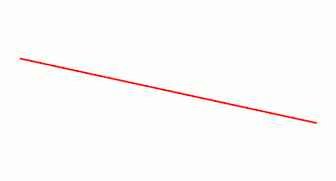Xiaolin Wu's line algorithm
Xiaolin Wu's line algorithm is an algorithm for line antialiasing.

Antialiasing technique
Xiaolin Wu's line algorithm was presented in the article "An Efficient Antialiasing Technique" in the July 1991 issue of Computer Graphics, as well as in the article "Fast Antialiasing" in the June 1992 issue of Dr. Dobb's Journal.
Bresenham's algorithm draws lines extremely quickly, but it does not perform anti-aliasing. In addition, it cannot handle any cases where the line endpoints do not lie exactly on integer points of the pixel grid. A naive approach to anti-aliasing the line would take an extremely long time. Wu's algorithm is comparatively fast, but is still slower than Bresenham's algorithm. The algorithm consists of drawing pairs of pixels straddling the line, each coloured according to its distance from the line. Pixels at the line ends are handled separately. Lines less than one pixel long are handled as a special case.
An extension to the algorithm for circle drawing was presented by Xiaolin Wu in the book Graphics Gems II. Just as the line drawing algorithm is a replacement for Bresenham's line drawing algorithm, the circle drawing algorithm is a replacement for Bresenham's circle drawing algorithm.
Algorithm
function plot(x, y, c) is
plot the pixel at (x, y) with brightness c (where 0 ≤ c ≤ 1)
// integer part of x
function ipart(x) is
return floor(x)
function round(x) is
return ipart(x + 0.5)
// fractional part of x
function fpart(x) is
return x - floor(x)
function rfpart(x) is
return 1 - fpart(x)
function drawLine(x0,y0,x1,y1) is
boolean steep := abs(y1 - y0) > abs(x1 - x0)
if steep then
swap(x0, y0)
swap(x1, y1)
end if
if x0 > x1 then
swap(x0, x1)
swap(y0, y1)
end if
dx := x1 - x0
dy := y1 - y0
gradient := dy / dx
if dx == 0.0 then
gradient := 1.0
end if
// handle first endpoint
xend := round(x0)
yend := y0 + gradient * (xend - x0)
xgap := rfpart(x0 + 0.5)
xpxl1 := xend // this will be used in the main loop
ypxl1 := ipart(yend)
if steep then
plot(ypxl1, xpxl1, rfpart(yend) * xgap)
plot(ypxl1+1, xpxl1, fpart(yend) * xgap)
else
plot(xpxl1, ypxl1 , rfpart(yend) * xgap)
plot(xpxl1, ypxl1+1, fpart(yend) * xgap)
end if
intery := yend + gradient // first y-intersection for the main loop
// handle second endpoint
xend := round(x1)
yend := y1 + gradient * (xend - x1)
xgap := fpart(x1 + 0.5)
xpxl2 := xend //this will be used in the main loop
ypxl2 := ipart(yend)
if steep then
plot(ypxl2 , xpxl2, rfpart(yend) * xgap)
plot(ypxl2+1, xpxl2, fpart(yend) * xgap)
else
plot(xpxl2, ypxl2, rfpart(yend) * xgap)
plot(xpxl2, ypxl2+1, fpart(yend) * xgap)
end if
// main loop
if steep then
for x from xpxl1 + 1 to xpxl2 - 1 do
begin
plot(ipart(intery) , x, rfpart(intery))
plot(ipart(intery)+1, x, fpart(intery))
intery := intery + gradient
end
else
for x from xpxl1 + 1 to xpxl2 - 1 do
begin
plot(x, ipart(intery), rfpart(intery))
plot(x, ipart(intery)+1, fpart(intery))
intery := intery + gradient
end
end if
end function
References
- Abrash, Michael (June 1992). "Fast Antialiasing (Column)". Dr. Dobb's Journal. 17 (6): 139(7).
- Wu, Xiaolin (July 1991). "An efficient antialiasing technique". Computer Graphics (publication). 25 (4): 143–152. doi:10.1145/127719.122734. ISBN 0-89791-436-8.
- Wu, Xiaolin (1991). "Fast Anti-Aliased Circle Generation". In James Arvo (ed.). Graphics Gems II. San Francisco: Morgan Kaufmann. pp. 446–450. ISBN 0-12-064480-0.